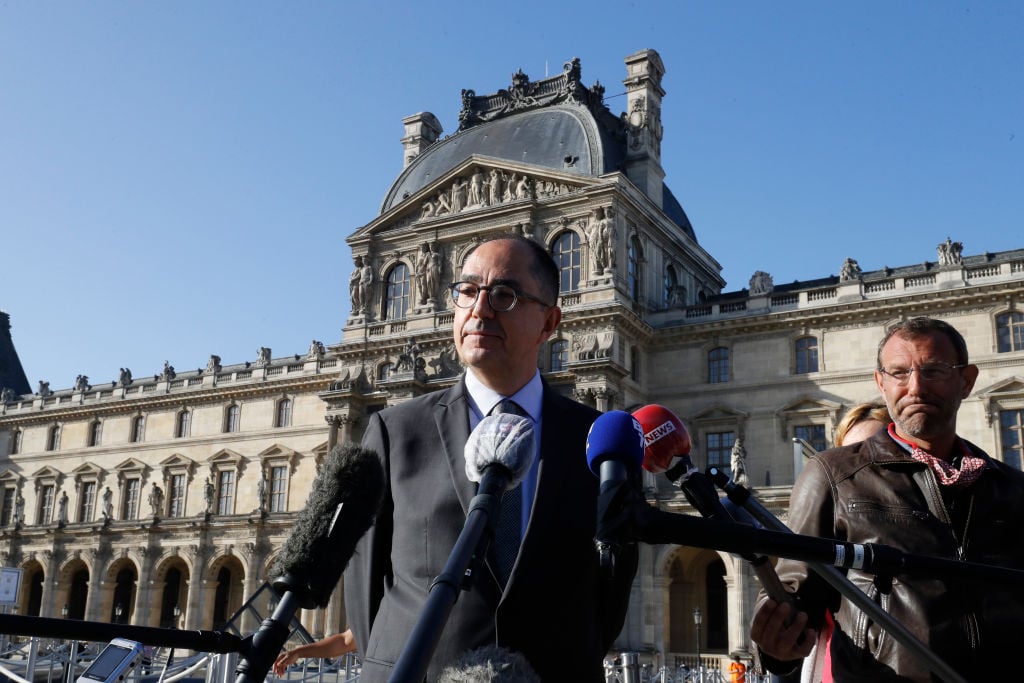
Jean-Luc Martinez, the president of the Louvre whose job security has been a matter of public speculation for weeks, has had his stay at the museum extended—at least temporarily.
Yesterday, April 13, the French culture ministry announced that Martinez would be named interim president as it continued to deliberate as to whether to renew his contract.
The government was due to announce yesterday whether Martinez, who has been president since 2013, would keep his job, but says the decision has been delayed due to the pandemic. Roselyne Bachelot, France’s culture minister, returned to work Monday after spending three weeks in a hospital with Covid-19.
Bachelot, who is believed to support Martinez, has reportedly drawn up a short list of six names for French president Emmanuel Macron, with whom the decision lies, to review. Contenders for the post include Sophie Makariou, president of the National Museum of Asian Arts Guimet; Laurent Le Bon, president of the Musée Picasso; and Christophe Leribault, director of the Petit Palais.
Martinez’s quest to remain in the post is “the equivalent of a presidential election,” according to French daily Le Monde. The executive, 57, has been on a media tour in recent weeks, offering interviews to newspapers, magazines, and television outlets explaining his achievements at the world’s most visited museum.
He has also been addressing controversies that have unfolded under his watch.
“There are always disputes but one doesn’t steer a cruise-liner like the Louvre by changing it completely,” Martinez told Le Monde. “Things take 10 or 20 years to be implemented.”
An archaeologist by training, Martinez was director of the Louvre’s department of Greek, Etruscan, and Roman antiquities from 2007 to 2013 before being appointed president. His mandate was renewed for three years in 2018.
In an interview with Paris Match, Martinez was emphatic that his archaeological background was crucial. “As an archaeologist, I am the best armed to answer the question about the provenance of works, which is becoming more and more important,” he said.
Martinez has certainly helped boost the Louvre’s popularity. Annual visitor numbers surpassed 10 million for the first time in 2018. The museum’s blockbuster 2019 Leonardo da Vinci exhibition alone attracted over one million visitors between October 2019 and February 2020. Under Martinez, the Louvre has introduced WiFi, online sales, and hourly visiting slots.
But the museum’s merchandising initiatives are under scrutiny. An Airbnb partnership competition offering winners a chance to sleep under I.M. Pei’s glass pyramid coincided with the city of Paris seeking to have regulations imposed on Airbnb. Another sponsorship, with the French carmaker DS Automobiles, which is selling a €54,000 “Louvre” limited edition car, plus branding partnerships with Swatch, Monopoly, and Uniqlo, have been derided by some.
Martinez says these partnerships help the Louvre reach a wider, younger audience. Around 75 percent of the museum’s visitors are foreign, and half are under the age of 30.
Asked about the Louvre’s reasoning when signing a deal with Netflix on the Lupin series, which was filmed partly at the museum, Martinez replied: “The main criterion is: ‘Will it serve the image of the Louvre?’ […] When one receives this kind of project, one shouldn’t hesitate.”
Other disputes revolve around acquisitions and rumors about Martinez’s management style. “His enemies accuse him of selling the museum to tourists, carrying out costly [renovations], buying mediocre works, and behaving like an autocrat,” according to Le Monde.
The museum’s acquisition of Juno in the Midst of Clouds (circa 1735) by Giambattista Tiepolo, an oval fresco in poor condition that was originally commissioned for the Sagredo Palace in Venice, has been highly contested.
According to La Gazette du Drouot, the Italian collector and dealer Pier Franco Grosso purchased it for €775,000 in 2004 and sold it to the Louvre in 2020 for €4.5 million, with €1.5 million coming from the Société des Amis du Louvre, the museum’s patrons group. Le Monde reported that the acquisition was opposed by the director of the Louvre’s paintings department.
Another issue is a lawsuit filed by the Cy Twombly Foundation earlier this year over the redecoration of a room that includes a permanent ceiling installation by the artist. The foundation says the changes have ruined Twombly’s work.
In Paris Match, Martinez lashed out against the complaint. “This quarrel appears at the moment when I’m asking for the renewal of my mandate. The renovations were planned since 2008, when we envisaged installing the collections of Etruscan art. The ceiling painted by Twombly, his last work, was made in full knowledge of this eventuality and is in his contract. The ceiling wasn’t touched, it won’t be and will always be there.”
If Martinez’s mandate is renewed, it will be his third and last term. He says he has no plans to lead any other museum.